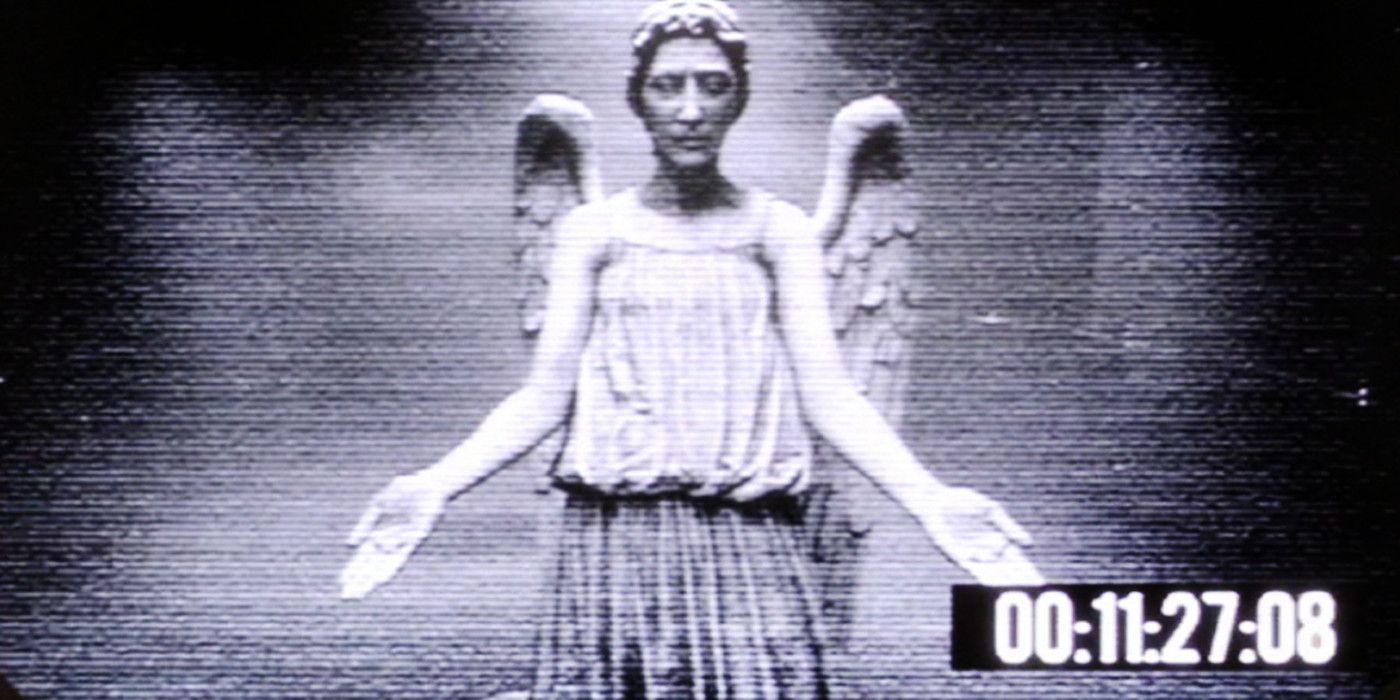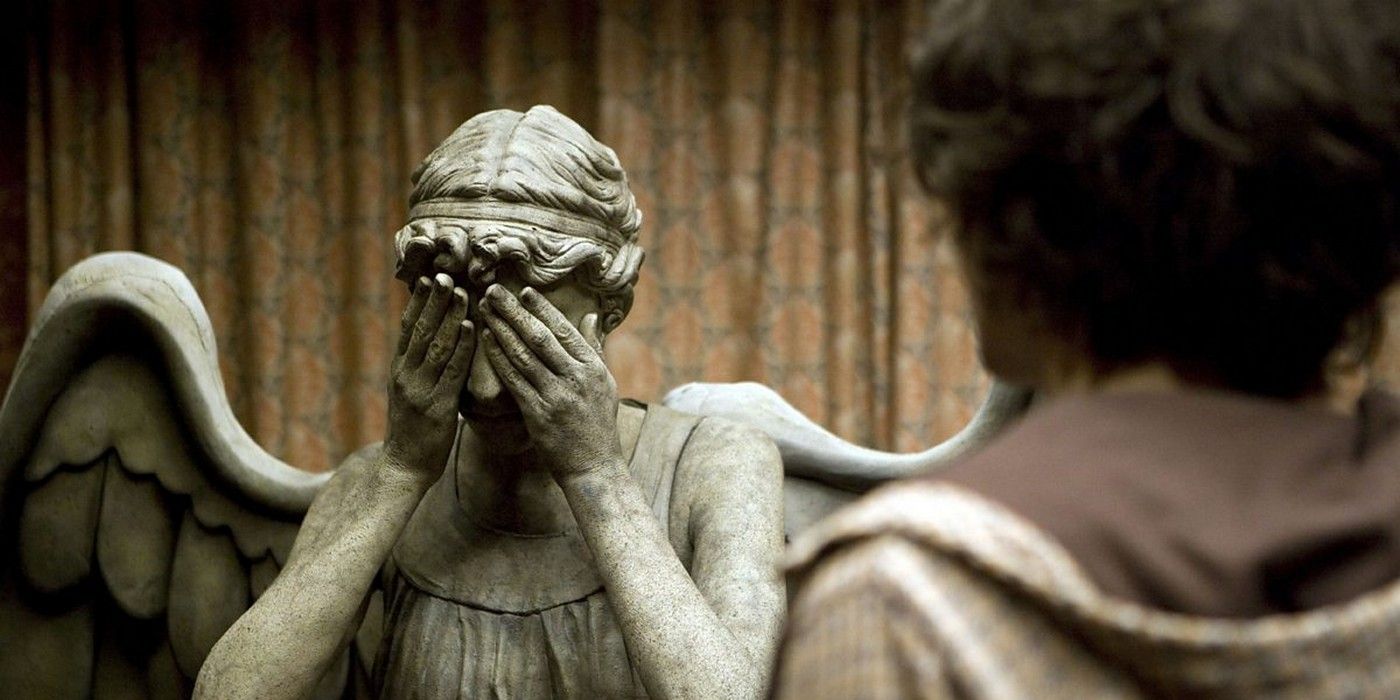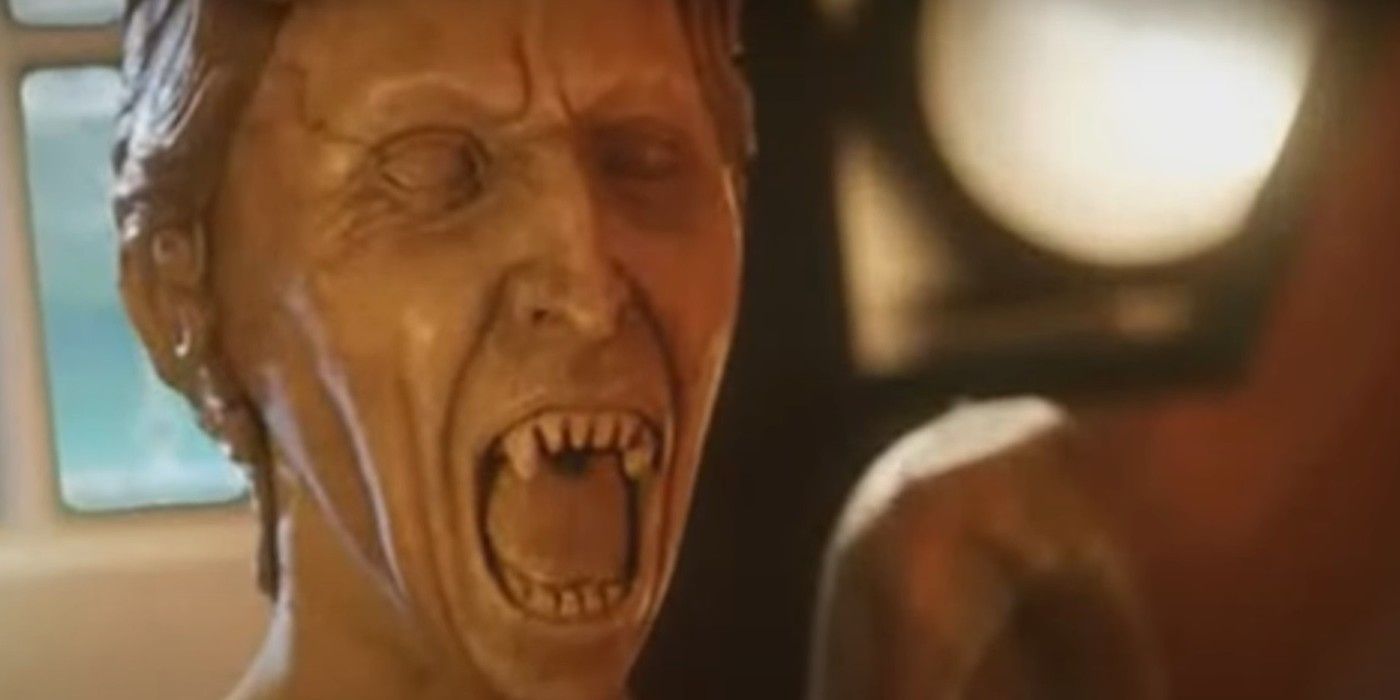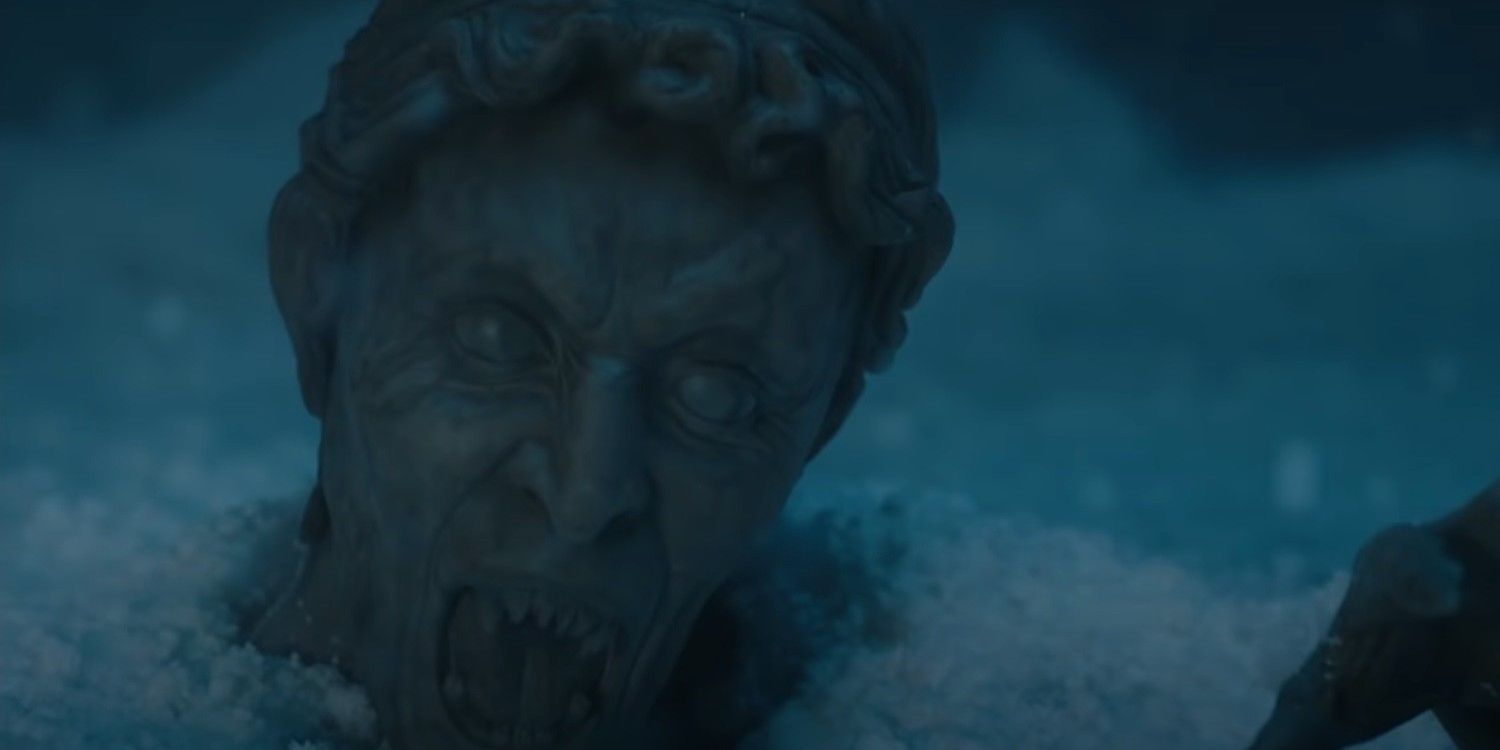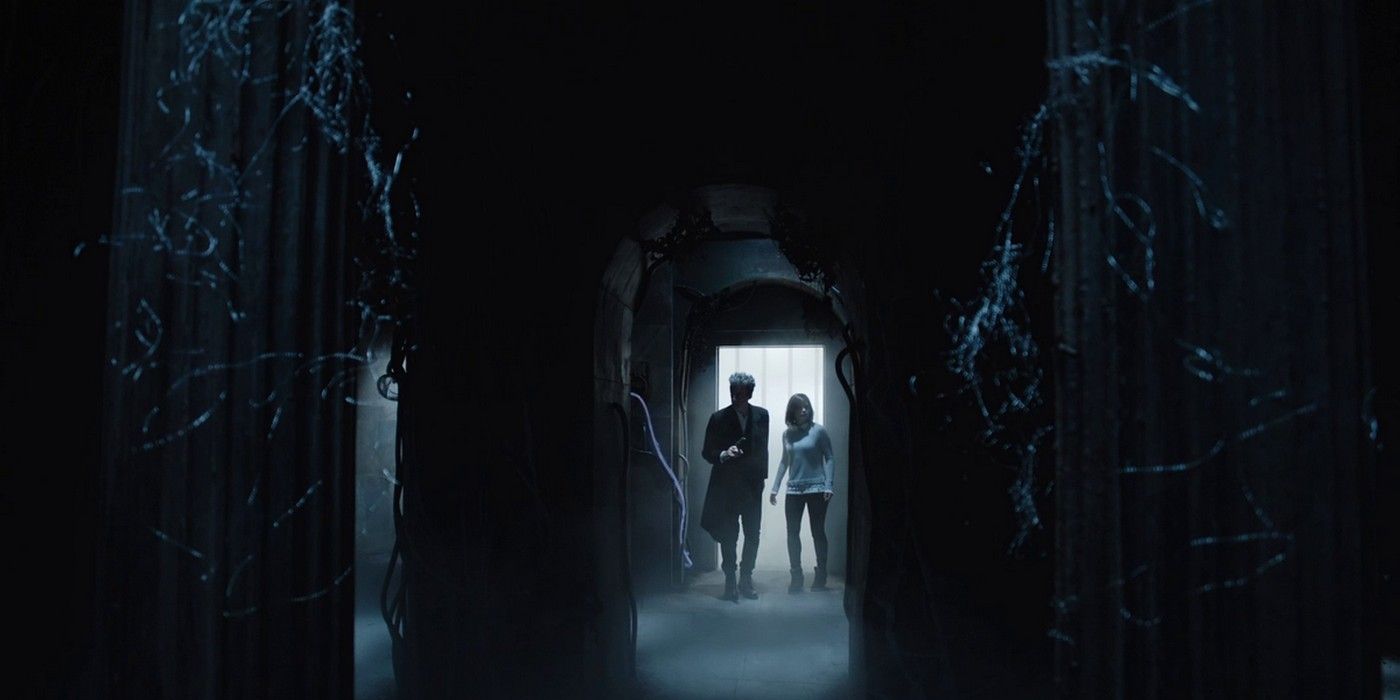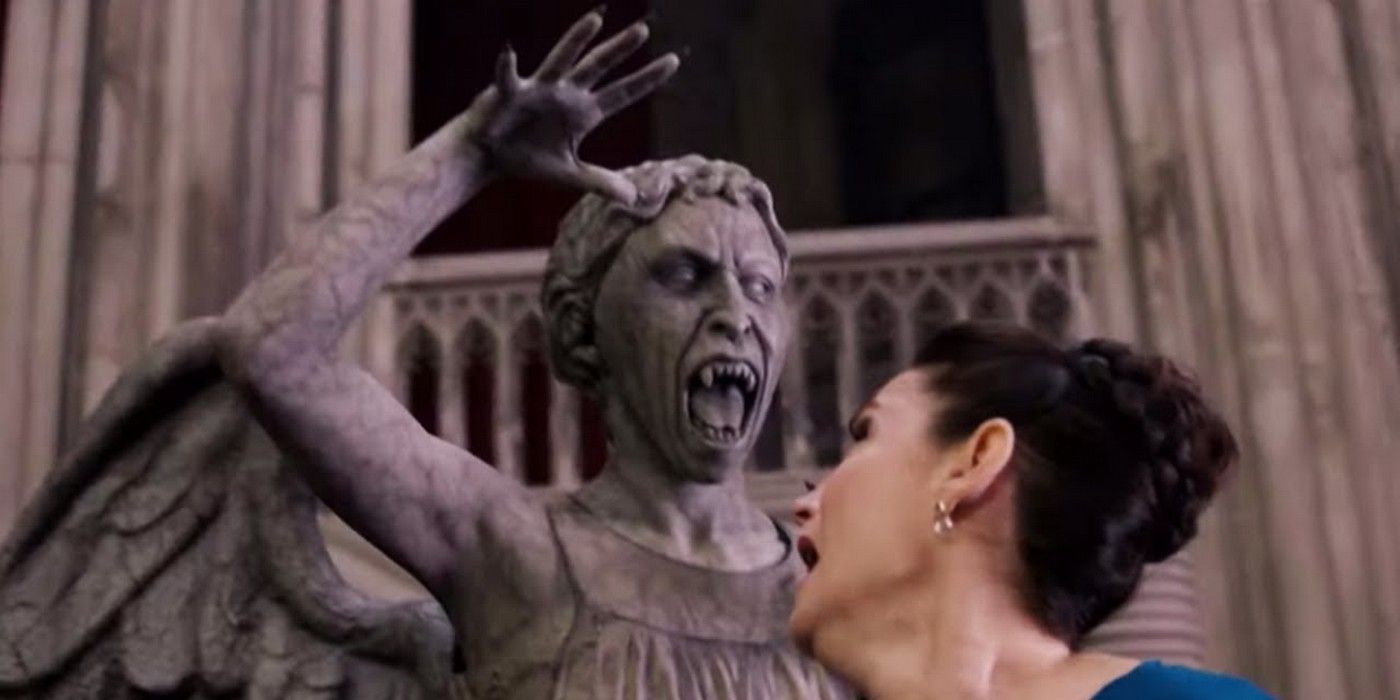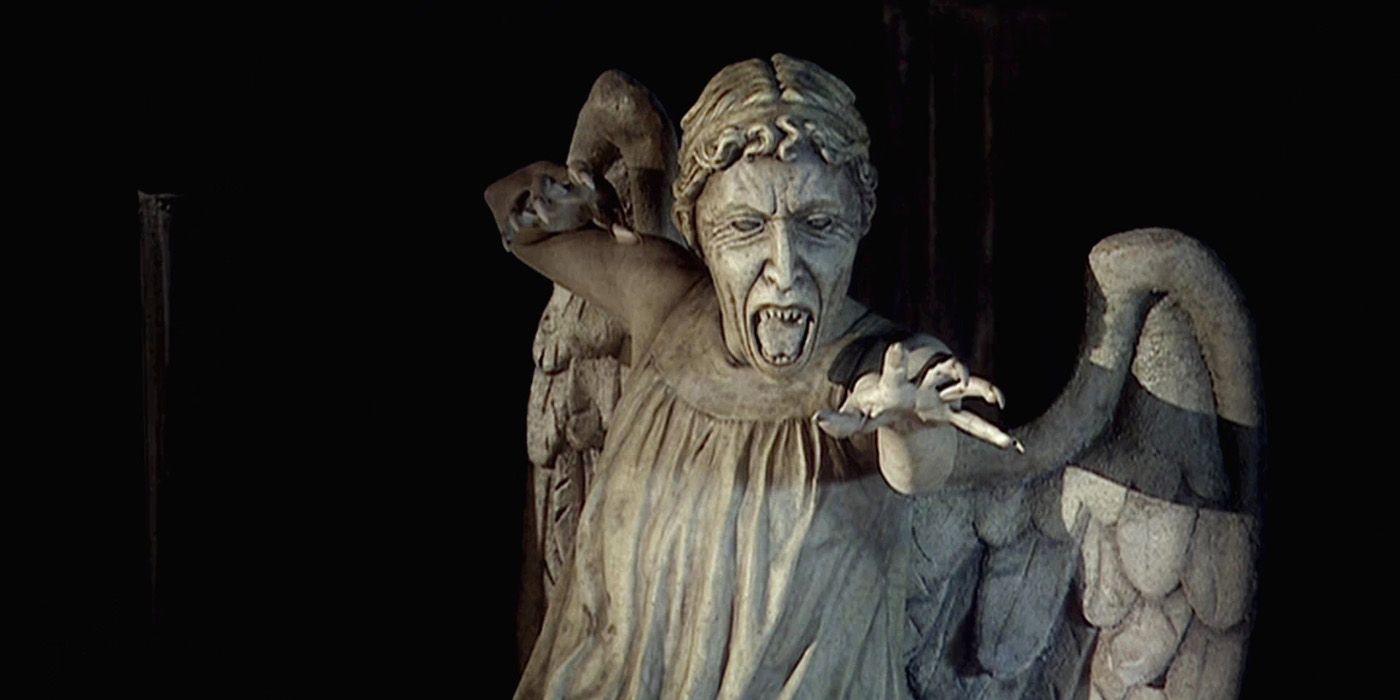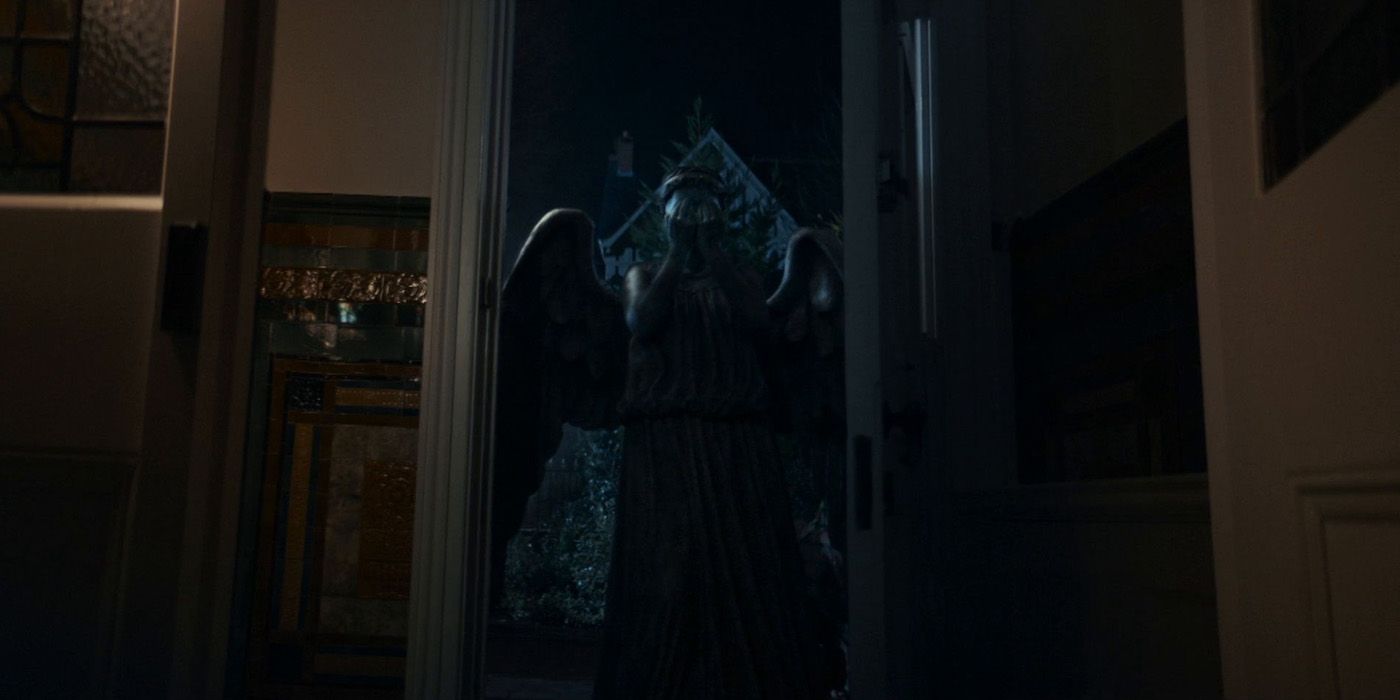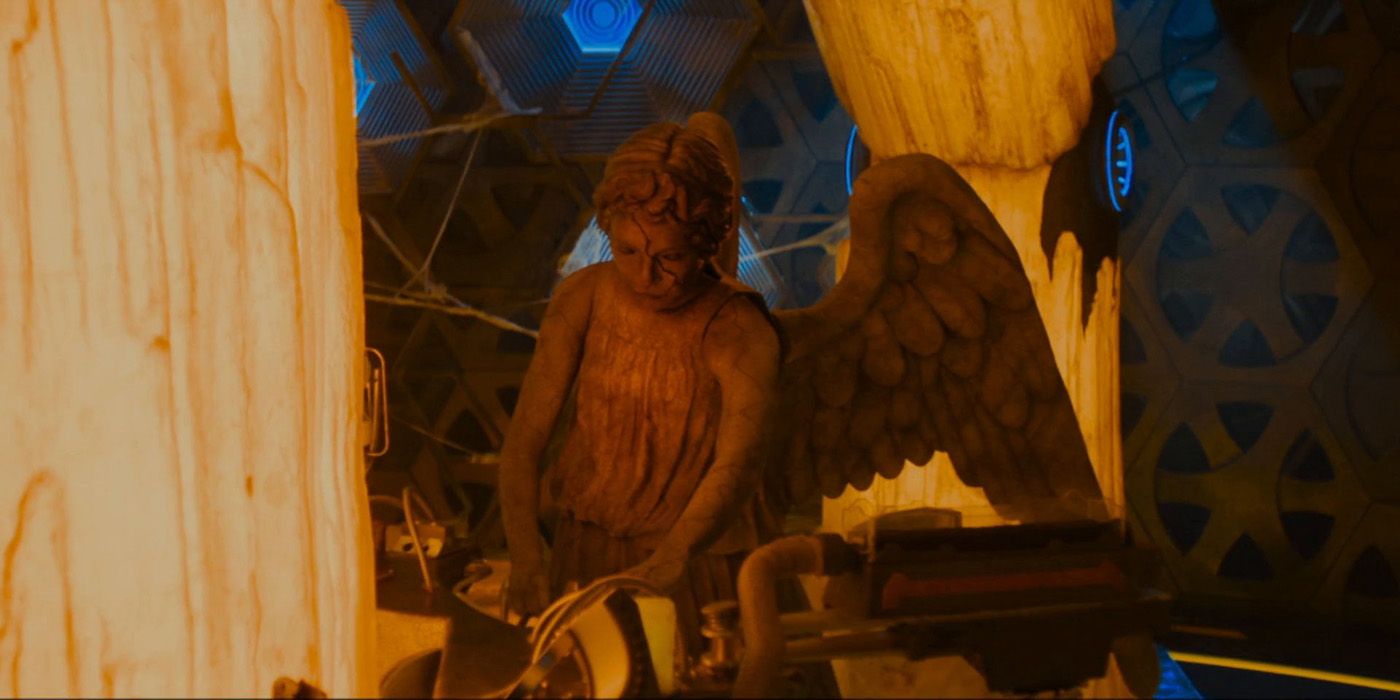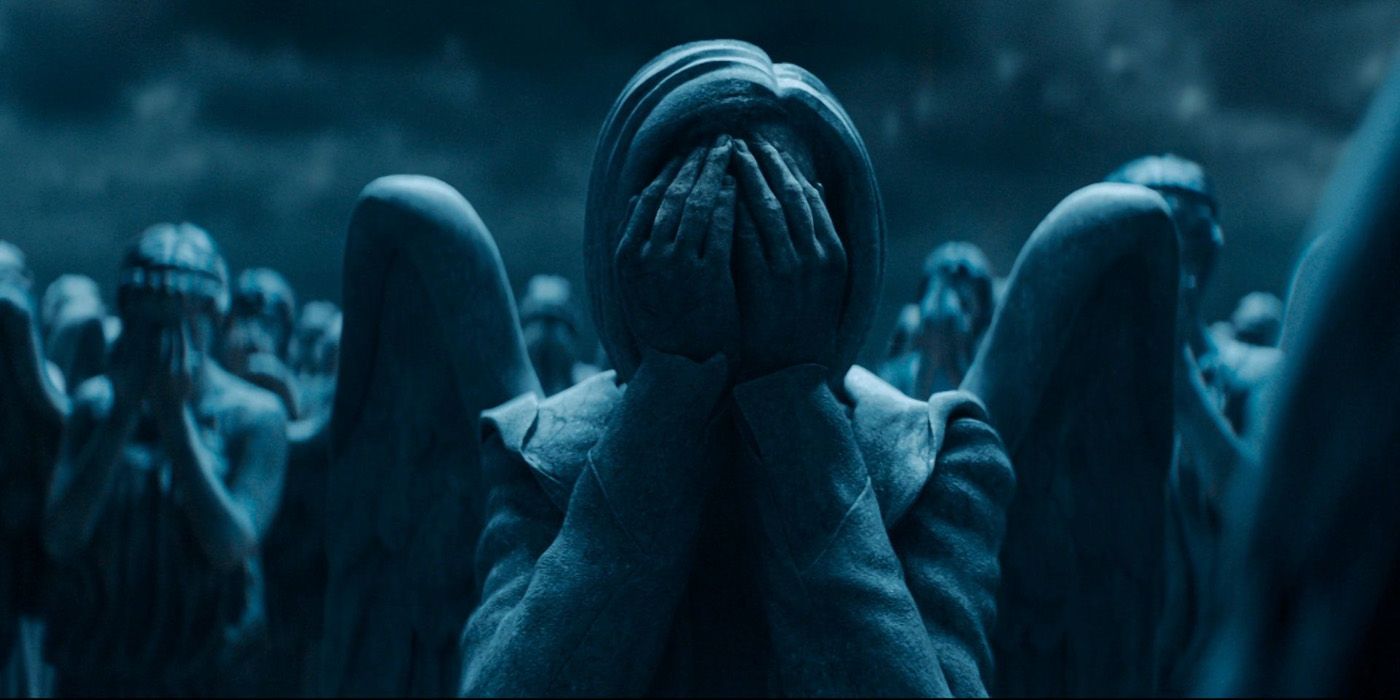The Doctor Who Weeping Angels episodes include some of the more terrifying moments in the entire show. Since returning to screens in 2005, Doctor Who relied heavily on classic villains, including Daleks and Cybermen. But Doctor Who has also introduced new villains to the franchise, with one of the best modern additions being the Weeping Angels. Introduced in Doctor Who season 3, the Weeping Angels are powerful, ancient villains scattered throughout the universe. The true origin of the Weeping Angels remains unknown, but that ambiguity only serves to make the villains even more frightening.
Since they only come to life when unseen, the Weeping Angels appear as statues, instantaneously turning to stone when they’re sighted. Keeping an eye on these villains is vital, as the Weeping Angels move with terrifying speed, meaning a single blink can mean death. Once catching its prey, a Weeping Angel sends a victim back through time, feeding off the life that person would’ve lived. The name “Weeping Angel” derives from how the creatures cover their eyes to avoid freezing each other. Doctor Who created a truly timeless monster when it returned in 2005, as the Weeping Angels episodes remain among the best in the show’s run.
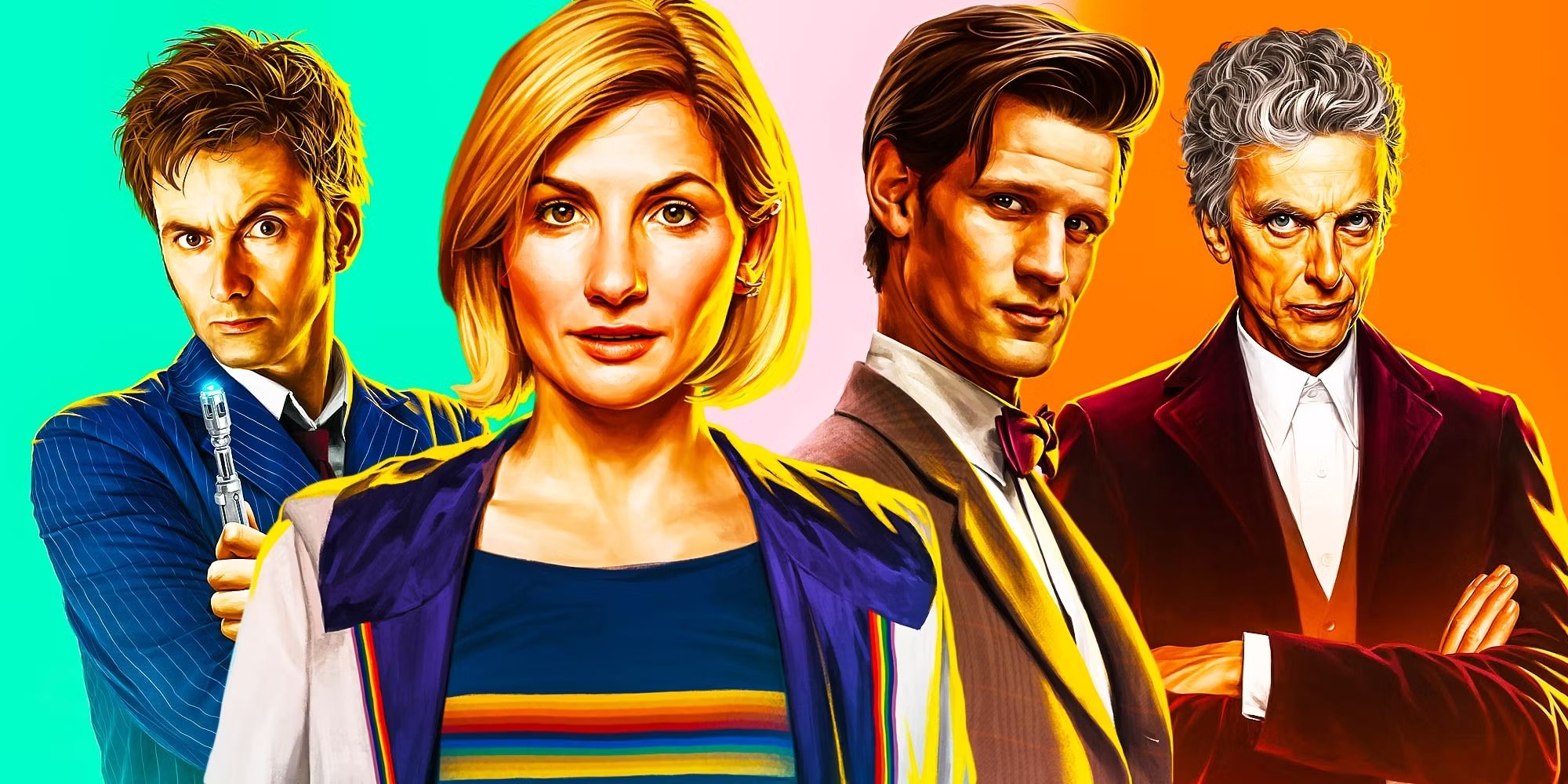
Related
Every Modern Doctor Who Season Ranked From Worst To Best
Jodie Whittaker’s time on the TARDIS has come to an end. There have been 13 seasons of Doctor Who, and here is the ranking from worst to best.
“Blink”
Season 3, Episode 10
It defies logic that a Doctor Who story with very little Doctor would be one of the most memorable, but that’s exactly what happened with “Blink”, the very first Weeping Angels episode. Played by a young Carey Mulligan, Sally Sparrow stumbles across an abandoned house full of Weeping Angels, and runs away with the TARDIS key after her friend falls victim to the lonely stone assassins. Sally receives messages from David Tennant’s Tenth Doctor (himself sent back in time by the Angels), instructing her how to defeat the fang-bearing statues.
Sally successfully evades the Weeping Angels’ “merciful” brand of death and protects the TARDIS key, helping The Doctor trick the angels into looking at each other. “Blink” immediately establishes the Weeping Angels as among the best Doctor Who villains, playing out like a mini horror movie with compelling characters, genuine scares, and a neat time-traveling twist. The episode launched Steven Moffat towards the showrunner job, made a Hollywood star of Mulligan, and is still consistently voted the best story modern Doctor Who has to offer.
The Time Of Angels/Flesh & Stone
Season 5, Episodes 4-5
The Weeping Angels wouldn’t trouble the Tenth Doctor again before his regeneration, but Matt Smith’s Eleventh Doctor wasn’t so lucky, meeting the Weeping Angels in season 5. Reuniting with River Song, The Doctor is taken to the wreckage of the Byzantium, a ship carrying the last, supposedly dormant, Weeping Angel. It’s soon revealed the crash was orchestrated to awaken an entire colony of starving Angels on Alfava Metraxis. In the second Weeping Angels episode, “Flesh & Stone,” The Doctor must balance defeating the Weeping Angels with the emergence of a crack in the fabric of time, threatening the whole of reality.
After briefly considering sacrificing himself, The Doctor sends the Weeping Angels through the crack instead, solving both problems. This two-part adventure introduces the idea that Weeping Angels can inhabit whatever takes their image, from reflections to TV footage, adding a new wrinkle to their mythology. While the return of Weeping Angels to Doctor Who was welcome, their comeback is somewhat overshadowed by the glut of long-term story threads spread over “The Time Of Angels” and “Flesh & Stone.”
The God Complex
Season 6, Episode 11
In the third Weeping Angels episode, the deadly statues weren’t the only threat facing the Doctor and his companions. Doctor Who season 6’s “The God Complex” introduces an illusory hotel, where each room contains a guest’s worst fear in a loving homage to The Shining. Making their way through this foreboding establishment, The Doctor, Amy Pond, and Rory accompany the eternally-terrified Gibbis into his own personal nightmare room, which contains Weeping Angels.
The Doctor maintains these Angels aren’t real, and can’t send any of the gang back through time. Amy shares her own experience with the Weeping Angels to calm him. The stone villains have little impact in “The God Complex,” appearing only for the added fright factor. Despite this, the Weeping Angels were utilized incredibly effectively during their short appearance. While brief, the Weeping Angels moments in “The God Complex” remain some of the most memorable over-all.
Good As Gold
2012 Olympics Mini-Episode
Following on from season 6’s “The God Complex” in 2011, the next time the Weeping Angels appeared was during the 2012 mini-episode, “Good As Gold”. It’s an incredibly noteworthy appearance for the terrifying Doctor Who villain, as they were the monster chosen for a celebratory episode to tie in with the 2012 London Olympics. The fact that it was the Weeping Angels and not, for example, classic foes like Daleks or Cybermen, chosen speaks volumes about just how popular the living statues have become.
Despite this short Weeping Angels episode clocking in at a mere 3 minutes and being penned by small children as a tie-in to the 2012 London Olympics, “Good As Gold” still features Matt Smith and Karen Gillan, so it can be considered Doctor Who canon (more or less). An athlete accidentally enters the TARDIS carrying the Olympic torch, and is followed by a Weeping Angel trying to steal the flame and “destroy the spirit it represents.” In a moment that would make the War Doctor despair, Eleven points his sonic screwdriver at the monster and blows its arm off, releasing the torch to its rightful owner.
The Angels Take Manhattan
Season 7, Episode 5
The Weeping Angels returned with a vengeance in Doctor Who season 7’s “The Angels Take Manhattan.” A quiet break in present-day New York turns sour when Rory is sent back to the 1930s by a stray Weeping Angel. The Doctor and Amy follow, teaming up with River Song to unearth a human farm in the Winter Quay apartment building, effectively allowing the Angels to send the same victims back through time over and over, including Rory. After his future self dies old and lonely, Rory determines to avoid his dark fate, and resorts to suicide, which could create a paradox that kills the Weeping Angels in New York. Amy joins him, and the plan is successful.
Although most of “The Angels Take Manhattan” technically never happened, a surviving Weeping Angel appears behind Rory in the closing moments, catching him off guard. Once again, Amy refuses to abandon her husband and gives herself up, leaving The Doctor behind to live happily ever after with Rory in the past. “The Angels Take Manhattan” restores the fear of Doctor Who‘s Weeping Angels, and the departure of Amy and Rory is undeniably sad. Interestingly, this Weeping Angels episode puts The Doctor in Sally Sparrow’s position of watching a loved one fall victim to the terrifying creatures.
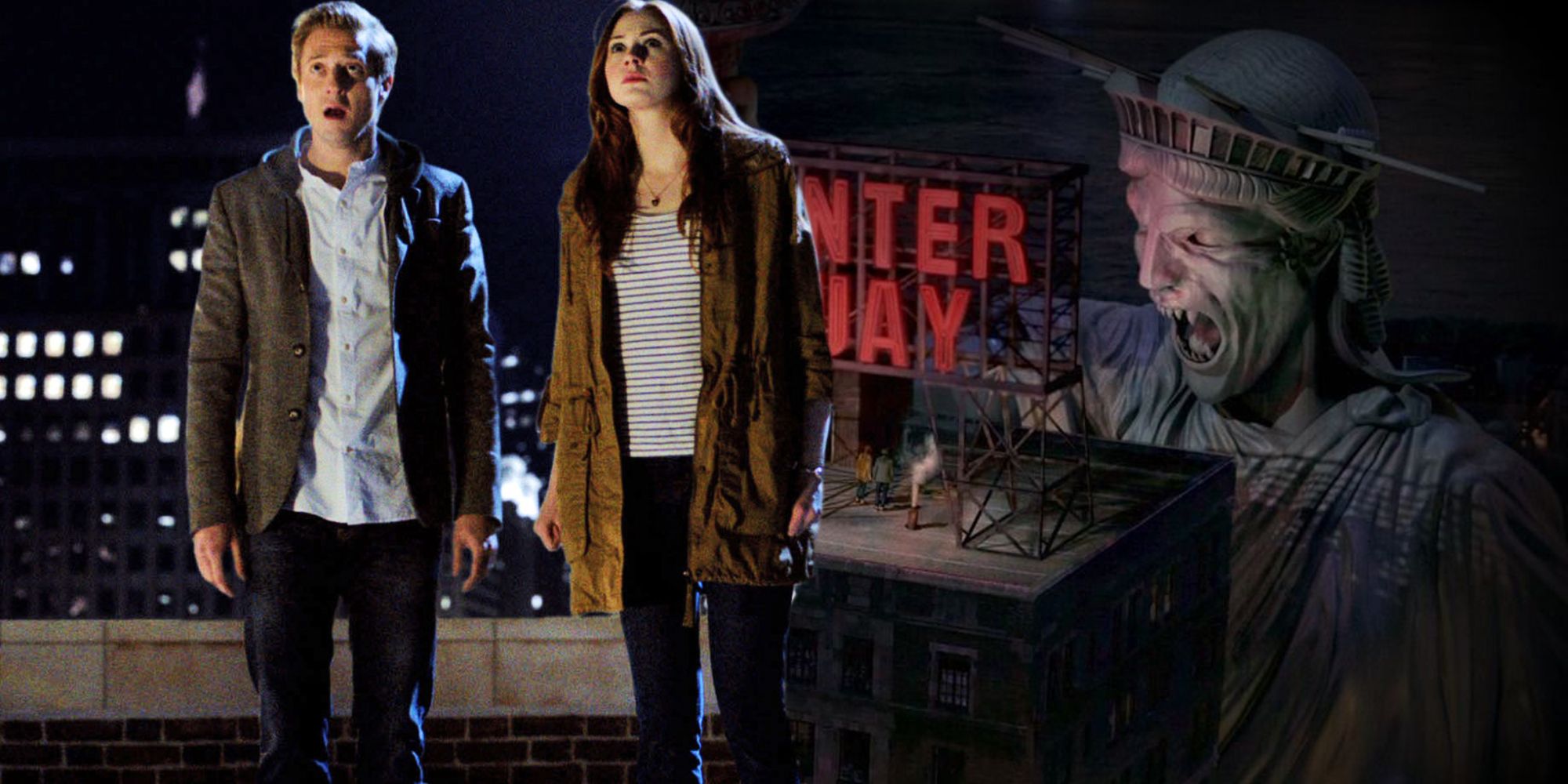
Related
Doctor Who Accidentally Created The Ultimate Weeping Angel
Doctor Who unintentionally created an unstoppable Weeping Angel, but it is possible the events of “The Angels Take Manhattan” somehow destroyed it.
The Time Of The Doctor
2013 Christmas Special
Matt Smith’s final episode, “The Time Of The Doctor,” featured all things Doctor Who. Finding himself on the planet of Trenzalore, The Doctor discovers the Time Lords are attempting to escape their pocket universe and return to reality, but only The Doctor holds the password to free them. The Doctor’s enemies catch wind of this, and storm Trenzalore in an attempt to prevent the Time Lords’ return.
The Weeping Angels attack The Doctor and Clara Oswald first by emerging from the planet’s snowy surface. Another Weeping Angel attacks during The Doctor’s centuries spent protecting Trenzalore, but is trapped staring at itself in a mirror. Much like the 2012 Olympic mini-episode, the presence of the Weeping Angels in the 2013 special says a great deal about how popular the Weeping Angels are. Appearing alongside classic Doctor Who monsters that have existed for decades was groundbreaking considering that the Weeping Angels were introduced in the show’s modern era.
Hell Bent
Season 9, Episode 12
Just as the Weeping Angels were present for the farewell of Amy and Rory Pond, they also feature in Clara Oswald’s final episode. The Twelfth Doctor’s first companion had already been killed in “Face The Raven” as part of a Time Lord scheme to trap The Doctor. After painstakingly fighting his way to Gallifrey for several millennia in “Heaven Sent,” The Doctor returns home and wants to rewrite his friend’s death by any means necessary. On the run from his own kind, The Doctor takes Clara through the fearsome Cloisters, which serves as a tomb for deceased Time Lords, and houses the famous Gallifreyan Matrix.
In ages past, the Cloister Wars were fought between the Time Lords and their enemies, and relics of that conflict remain trapped in the bowels of Gallifrey to this day, including a Dalek, a Cyberman, and a Weeping Angel. As in “The God Complex,” this episode uses the Angels for a momentary scare, but the prospect of an ancient war between Time Lords and the Weeping Angels makes them even more interesting.
This also marks a pivotal moment for the Weeping Angels in terms of the significance of the Weeping Angels as a Doctor Who adversary. There were plenty of candidates for the third race to join the iconic Daleks and Cybermen in the Cloister Wars. The fact that the Weeping Angles were chosen over, say, the Sontarans was a huge acknowledgment from the Doctor Who creative team, signifying that they recognized the creatures from the “new-Who” era were now fan-favorites equally to the classic villains with decades of history.
The Lost
Class Season 1, Episode 8
Since Peter Capaldi appeared in Class‘ very first episode, it’s impossible to ignore the presence of the Weeping Angels in the finale. Revealed as the overarching villains of the Doctor Who spinoff series, the Weeping Angels had been controlling the board of Governors at Coal Hill School, preparing them for a mysterious event known as “The Arrival.” Since BBC canceled Class on a cliffhanger, the Weeping Angels’ master plan was never revealed.
According to Class showrunner, Patrick Ness, season 2 of the Doctor Who spin-off would’ve focused more heavily on the Angels and explored their home planet (via Radio Times).
“I’d envisioned the civil war and the planet like that. Something only comprehensible in a small way, with so much of it remaining a mystery, reminding us that there are paths we’re just never going to understand.”
There have been several Doctor Who spinoffs over the years, such as The Sarah Jane Adventures (2007-2011) and Torchwood (2006-2011). Unfortunately, while other Doctor Who spinoffs managed to finish their narrative, Class never did. This was a shame not only for fans of the show, but also for the Weeping Angels themselves, as the short-lived spinoff looked set to significantly flesh out their lore and backstory.
The Lie Of The Land
Season 10, Episode 8
The season 10 Weeping Angels episode, “The Lie of the Land” starts with a moment that throws viewers off. Earth is now being ruled by the Monks, a secretive group who have been ruling the planet since the dawn of time. There are statues of them all over the planet, and everyone worships the beings. However, Bill knows that they haven’t been on Earth since the dawn of time and only arrived six months prior.
The Doctor knows what is happening, but he isn’t sure how to beat these beings and learns that Bill’s death might be the only way to stop this. In a last-ditch effort, The Doctor broadcasts his thoughts to the world, including threats to the planet, including the Weeping Angels from the episode “Blink.” It’s an incredibly short appearance, but one that shows how effective they are when used to convey themes of threat and danger in the world of Doctor Who.
Revolution of the Daleks
New Year Special 2021
The appearance of the Weeping Angels in season 12 was once again just a small cameo to remind viewers that they are still around in the Doctor Who universe. In this episode, The Doctor was still held prisoner by the Judoon ever since the end of the previous season. Captain Jack Harkness returned for the first time in 10 years and the Daleks were back in a new sleeker design.
Before her rescue, The Doctor was held prisoner with several other very familiar characters, including one Weeping Angel. The Doctor even named this Weeping Angel “Angela.” It was an incredibly fan-pleasing moment, and also one that subtly went a great deal toward integrating the Weeping Angels with the wider Doctor Who universe. Seeing a Weeping Angel held prisoner by another race was a fascinating moment, and got plenty of imaginations running among the Doctor Who fandom.
The Halloween Apocalypse
Season 13, Episode 1
The 13th season of Doctor Who begins with The Doctor and Yaz chasing Karvanista before they encounter a woman named Claire, who says she will meet The Doctor in the future. However, when Claire tries to go home, she sees a Weeping Angel coming for her. She knows not to blink, but can’t help it and ends up displacing her in time. This episode starts the story of The Doctor battling the Flux, and the Weeping Angel is part of this storyline. In this case, it is an Angel who is sent to recapture an Angel that split from the Division’s faction of Angels.
The premiere of Doctor Who season 13 came in 2021, a full 14 years after they made their debut in 2013’s “Blink” in 2007. Doctor Who had changed significantly as a show, and there were plenty of monsters from the earliest seasons of the modern Doctor Who era that were never seen again. The Weeping Angels being selected as the first foe in the show’s 13th season was just as well-received as the appearance of classic villains was back in season 1 of the modern Doctor Who episodes, all the way back in 2005. It highlighted the fact that, by this point, the Weeping Angels had come to be considered classic Doctor Who monsters too.
Once, Upon Time
Season 13, Episode 3
Many fans were delighted when episode 3 of Doctor Who season 3 came around, as the Weeping Angels appeared not once, but twice during the 2021 batch of adventures. In the third part of the multi-episode Doctor Who storyline where The Doctor is battling the Flux, a Weeping Angel continues to torment The Doctor and his allies. The first Weeping Angel in this Doctor Who episode is seen by The Doctor when they are escaping an attack from the Swarm.
Yaz is next to see one as it is in her rearview mirror, but it is not there when she turns around. When The Doctor slips into Sonya, a Weeping Angel appears in a video game she is playing. This all leads to the end of the episode where a Weeping Angel leaps out of Taz’s phone and takes control of the TARDIS. This feat showed just how powerful the Weeping Angels truly are, and that viewers may only have witnessed a fraction of their capabilities.
Village of the Angels
Season 13, Episode 4
Season 13 spent a lot of time with the Weeping Angels, and many fans expressed their delight online that the 2021 season was kickstarting with a full multi-episode adventure that heavily focused on the living statues. The Weeping Angels were never more powerful than they were in “Village of the Angels.” At the end of the previous episode, the Weeping Angel took over the TARDIS and in this episode, The Doctor finds herself battling an army of Angels.
These Angels are an Extraction Squad working for the Division, and their goal is to capture The Doctor. This is also one of the most distressing appearances of the Doctor Who villains, as neither The Doctor nor her allies have a chance. In the end, the Weeping Angels capture The Doctor for the Division. In terms of how “Village of the Angels” meant for the villain in a more meta-sense, it solidified season 13 as the first time the Weeping Angels had been given their own grand narrative arc just like classic foes such as Davros, the Master, and, of course, the Daleks.
Survivors of the Flux
Season 13, Episode 5
The most recent appearance of the Weeping Angels showcased just why the Doctor fears them so much, and showed their powers and abilities are even more terrifying than viewers could ever have imagined. The second part of the Flux arc sees The Doctor captured and turned into a Weeping Angel herself. She finds her captors can revert her to a human and back into a Weeping Angel as they desire, which creates a unique body horror element to add to the terror the Weeping Angels already present.
The Doctor also admits later that the Weeping Angel who tracked her down holds her memories, showing how powerful they really are. However, the real villain was the Division, and the Weeping Angels were used as soldiers for them, showing that they are not as independently threatening as when they first appeared on Doctor Who.
